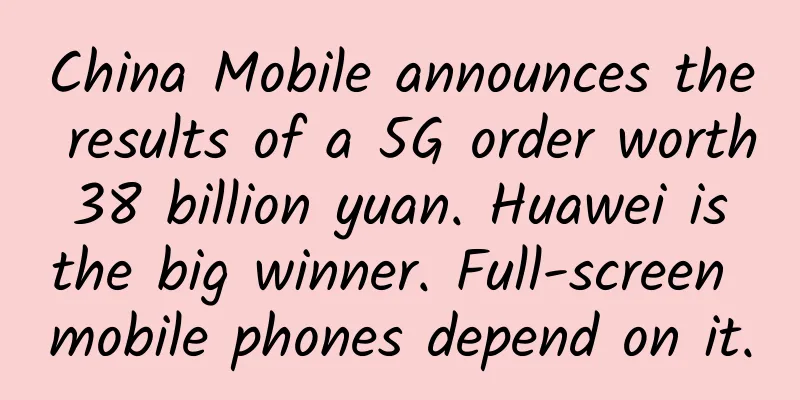There are more than 400 million 5G terminal users nationwide. Why are we still “unaware” of 5G?

|
According to news from CCTV.com in September this year, a relevant person in charge of the Ministry of Industry and Information Technology introduced that from January to August this year, domestic 5G mobile phone shipments reached 168 million units, an increase of 80% year-on-year. my country has built a total of 1.037 million 5G base stations, covering all prefecture-level cities, more than 95% of county towns and 35% of townships in the country. The number of 5G terminal users has exceeded 400 million. China has built the world's largest 5G network! However, we don't seem to have much feeling for 5G. According to the "2020 Communications Industry Statistical Bulletin" released by the Ministry of Industry and Information Technology in 2020, my country's 4G users reached 1.289 billion. Although 5G users are increasing, the speed is very slow. From 2019, the first year of 5G, to now, two years have passed, and 4G users still dominate. On the surface, the packages are too expensive, with the cheapest package costing 60 or 70 yuan a month. In terms of signal, the experience is poor in extreme cases, and the signal on the highway is sometimes worse than 4G. Switching to a 5G package does not bring much qualitative change except for a faster network speed. In fact, these are not the main reasons. In the 3G and 4G eras, user needs always came before technology. Before the advent of the 3G and 4G eras, people had already done some practice and research on mobile computing scenarios, rather than using new technologies to think about needs. The situation is just the opposite in the 5G era. Users themselves do not have very obvious demands, and it seems that the efforts to match the demands through new technologies have not been successful. We are generally indifferent to 5G, mainly due to the following four aspects: High coverage costDue to signal frequency, wavelength and transmission attenuation, a 2G base station can cover 7 kilometers, a 4G base station can cover 1 kilometer, and a 5G base station can only cover 300 meters. There are approximately 5 million 4G base stations in the world, and China accounts for more than 3.4 million of them. It can be said that we have invested a lot of money in 4G coverage. Unlike many developed countries, operators do not provide 4G services in many remote areas in order to save costs.
If China wants to replace all the original 4G coverage areas with 5G services, it will need at least 13.6 million base stations. The price of a 5G base station is between 200,000 and 600,000 yuan, and the total investment will reach a staggering 6.5 trillion yuan! At the 2021 China International Information and Communication Exhibition, Xin Guobin, Vice Minister of the Ministry of Industry and Information Technology, said that as of August 2021, my country had built more than 1 million 5G base stations. Although this data accounts for more than 70% of the global number, there is still a big gap from complete national coverage. The high coverage cost makes it impossible for 5G to achieve full coverage in a short period of time, and the 5G experience in many areas is even worse than 4G. 5G base stations consume high powerGenerally, the power consumption of a single 4G system is 1300w, while that of a single 5G base station system is about three times that figure, Huawei's is 3500w, and ZTE's is 3255w. In this way, under the premise of the same coverage area, the power consumption cost per unit area of 5G is 12 times that of 4G! Full coverage is enough to turn an operator's profit into negative numbers for the year.
Rising costs are the main reason for the increase in 5G package charges. For price-sensitive users, some users prefer to use 4G networks rather than 5G networks, which are expensive and have little improvement. The bearer network needs to be expanded on a large scaleTheoretically, 4G speeds can reach 100 mbps, but in reality this speed cannot be achieved because there are too many users, causing the bearer network to be unable to withstand such a large traffic demand. The average user speed is between 30-80 mbps. If you simply replace 4G base stations with 5G base stations without large-scale expansion and transformation of the bearer network and backbone network, the 5G rate will remain the same as the 4G rate. In this way, the only advantage of 5G at present will disappear. If the speed does not change, users will be even less sensitive to 5G. 5G EcosystemThe 5G ecosystem is the main reason why users are not interested in 5G. In the early days of 5G promotion, many people believed that it would bring new possibilities to technologies such as VR, autonomous driving, and AI. However, to date, we find that 5G has limited benefits for these industries. Autonomous driving does not rely on the Internet, but on the computer in the car. If the network signal is poor, the car will be unable to drive, and the safety of autonomous driving cannot be guaranteed. Because the bandwidth and lines from base stations to servers are the same as 4G, 5G's low latency will not be a qualitative leap. As for watching 4K and 8K videos, not only will the power consumption increase, but videos of such resolutions are already beyond the range of what the human eye can perceive. We don’t have much feeling about 5G at present. Does it mean that 5G is useless? Xiao Wei can't help but think of the topic of "Metaverse" recently. Is "Metaverse" the future? Of course, any company can position the creation of "Metaverse" as its strategic goal. However, due to the hype of capital, major media and platforms abused the concept of Metaverse for profit, making Metaverse gradually fade away. Around 2019, 5G was widely hyped, but in reality the effects of 5G were far below expectations, leading many people to think that 5G was a scam. What did 4G bring? Short videos and various forms of personal live broadcasts, which only appeared when the penetration rate of 4G was high. At present, the penetration rate of 5G is still relatively low, and it will hardly bring any new features. For now, it is just an upgraded version of 4G, nothing more. Just as autonomous driving will replace manual driving and artificial intelligence will replace human labor, 5G will also inevitably replace 4G, but there is still a long way to go to completely replace 4G. Only by putting aside unrealistic fantasies, being down-to-earth, and treating 5G calmly can we give it a bright future instead of letting it become a tool for cutting leeks. |
<<: Inventory: 10 hottest Internet startups in 2021
Recommend
NTT provides one-stop overall solution for international schools based on Cisco digital network architecture
The tide of digitalization has already affected e...
10 pain points: How IT departments face edge computing
From networking and integration to failover, asse...
On the Importance of Redundant Backup in Data Centers
It is a commonplace to say that data centers need...
One year after the license was issued, China's 5G commercialization yesterday, today and tomorrow
A lot can change in life in a year, and for the 5...
Wu Hequan, Academician of the Chinese Academy of Engineering: IPv6 will become the carrier platform of the new generation of IT and will develop in parallel with computing power network
[[432879]] The 2021 China Mobile Global Partner C...
By 2026, NB-IoT market size will exceed US$31.9 billion
According to a Valuates report, the global narrow...
Omdia: Global Gigabit Broadband Users to Exceed 187 Million by 2025
LightReading reports that the COVID-19 pandemic h...
From January to May, my country's telecommunications business revenue totaled 612.7 billion yuan, a year-on-year increase of 6.7%.
[[407105]] On June 23, according to the "Eco...
Ruijie launches the new generation of smart classroom "A Good Class" to activate education informatization 2.0
On April 2, Ruijie Networks held a new product la...
Differentiate switches based on network coverage
As the number of switches increases, there are ma...
6 tips to avoid automation disasters
Senior software engineer Benjamin Willenbring was...
Spectrum is scarce and expensive. Should 2G be retained or abandoned? This is a big question that operators need to consider.
According to foreign media reports, in just a few...
Hostwinds: VPS/cloud server from $4.99/month, Seattle/Dallas/Netherlands data center, supports Alipay
Hostwinds is a long-established foreign hosting c...
The number of 5G base stations has reached 1.159 million. The Gigabit optical network has the capacity to cover more than 200 million households.
Yesterday, the State Council Information Office h...



![[Black Friday] TMThosting: 30% off monthly payment for Seattle high-security VPS, 10% off for dedicated servers, supports Alipay](/upload/images/67cac02248693.webp)





